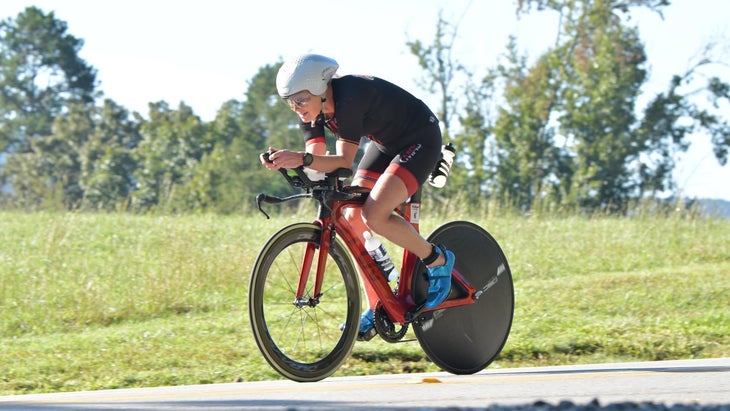New perk! Get after it with local recommendations just for you. Discover nearby events, routes out your door, and hidden gems when you sign up for the Local Running Drop.
Train 360 is our new training column, designed to give you a deeper look at the many different aspects that go into a professional athlete executing a key workout. A key workout is considered a session that will yield significant fitness gains and is often positioned in a training program so that the athlete can hit it feeling relatively fresh and able to give it their all. As well as the key workout (which is listed in full below), there are many other factors to consider, including: “primer” sessions in the days leading in, activation and mobility exercises beforehand, fueling and nutrition (both before, during, and after the workout), mental preparation, and all of the gear and equipment involved. We’ve got it all outlined below from Mel McQuaid, who recently finished third at Ironman Chattanooga. McQuaid is a three-time XTERRA world champion and former pro cyclist who has been racing triathlon for more than 20 years. Aged 48, she’s got a wealth of experience at nailing key workouts, including this long ride detailed below. If you’d also like to check out the first in the Train 360 series, we looked at the FTP bike session of three-time Ironman world champion Mirinda Carfrae…
The Purpose
This workout is essentially an enormous aerobic sandwich that I like to do the day after a quality workout on the bike. Increasing the density of my aerobic riding by placing two rides side by side in the week increases the training stimulus and seems to work really well for me. I don’t always add the intervals, sometimes it is just a long Zone 2 ride, but in the eight weeks before going into an Ironman I like to maximize the time in the low aerobic threshold range. Long rides are great for general fitness and rides at this intensity are good for strength and durability because they demand enough of your attention that you have to ride well to hit the watts, but low enough intensity to accumulate a significant volume of time.
The Basics
The workout involves a 30 to 60-minute warm-up, starting out gently and gradually building to a Zone 2 effort (which equates to 55-75% of FTP—functional threshold power—for those riding with power or rate of perceived exertion, RPE, 5-6/10 for those going by feel). The main set is five to eight rounds of 20 to 25 minutes at Zone 2 to Zone 3 effort, which is 80% of FTP or RPE 6-7/10, taking five to 10 minutes recovery between each interval. You don’t necessarily need to dive straight into this, though, as McQuaid explained that she eases into it gradually: “I will build up to the eight rounds of 20-25 minutes, and a good way to start is with something like six rounds of eight minutes, taking three to four minutes rest, and then, over time, slowly increasing the time at intensity without increasing the rest too much.
RELATED: How to Establish Triathlon Training Zones
The Workout
30-60 min. warm-up, building to Zone 2 (55-75% FTP)
5-8 x 20-25 min. @ Zone 2/3 (80% FTP) with 5-10 min. rest between each interval
20-30 min. cool-down @ Zone 2

The Day Before
“To truly get the ‘aerobic sandwich’ value of this workout, the day before involves a two- to three-hour bike interval session with work above my FTP, either just above threshold at 105-110% of FTP if it is before an Ironman, or even higher (VO2 max and higher range) if I am preparing for shorter distance races. There will typically be about 20 to 40 minutes of intervals within the total ride, and I’ll aim to do it mid-afternoon, with the long ride in the morning the following day. Going into this workout with a harder day preceding it is important and increases the fatigue resistance stimulus.”
Gear
“I prefer to do this workout on my Liv Avow time trial bike in the aero position outside. This is really a foundation Ironman workout so I think keeping most of the gear/variables the same as you’d use on race day is ideal. I usually ride Shimano DuraAce tubulars in racing so I will use them if a race is coming up. In the early season, I build up to this set using my gravel bike and hills. I am much more natural on a bike on the dirt than I am on a TT bike.”
- Liv Avow TT bike
- Shimano DuraAce C50 tubeless wheelset
- Shimano DuraAce 2x 54/39T & 11/25 cassette
- Stages dual-sided 170mm Shimano DuraAce cranks
- Xlab Torpedo front bottle mount
- XLab Chimp carbon cages
- Cobb Max Saddle
- BioRacer Aerospeed tri suit or Bioracer Tri shorts
Fuel
“I like to fuel in the 300-350 calories per hour range to be constantly trying to improve my absorption of nutrition and also to speed up my recovery from days like this that would other be hugely depleting. Eating well during workouts is another variable I have addressed that is helping me continue to improve my performances as I get older. I fuel in this workout on the schedule that I maintain on race day, so I try to get anywhere from 65-75g of carbs per hour and drink 1.5 to two bottles an hour depending on conditions. I find I can train on a regular diet, so I don’t adjust fiber or anything for my main training weeks.”
Mental Focus Points
“I will listen to music if I have to do the session indoors, but mostly I try to think about execution. The intervals are hard enough that you have to pay attention to maintain the effort but long enough that maintaining it gets really mentally challenging. I think this is the perfect state to specifically practice conditions for racing an Ironman.”
Solo or Group?
“I do this workout on my own every time. This type of work isn’t effective in a group because so much of the benefits come from learning to focus. I think Ironman training has to include sessions alone to get used to the personal struggle that the discipline of long-distance triathlon presents.”
Pre-Workout Mobility
“I teach a Monday Mobility session with my group of athletes every Monday evening. We spend an hour addressing mobility in a consistent and meaningful way. From that class, I have a shorter routine called the Rad Reset (a 12-minute routine that involves 12 exercises) that I will do after any harder key session to ensure my body recovers well. I specifically do a lot of work on my thoracic spine after riding my TT bike.
“The mobility I do weekly is a combination of strength moves (incorporating squat, hinge, pull, and press) mixed with some range of motion work (mountain climbers, banded overhead reach, leg swings, hurdles) with flexibility (stretching and yoga poses). I will mix these moves with some self-myofascial release (ball trigger points, foam roller) and I like to have a different objective from week to week. Some weeks I obsess about feet and calves, others I go nose to toes, and some weeks it is thoracic spine. The main thing is I am ruthlessly consistent about spending an hour doing this once per week and I always do the Rad Reset after every run.”
RELATED: Ask a Trainer: Why Should Triathletes Care about Mobility?
Post-Session Activities/Recovery
“Immediately after a session I like to make a smoothie with water, protein powder, bananas, fruit, Greek yogurt, and collagen protein, and then usually I just eat a normal meal. I do not nap, but I get nine hours sleep per night—that’s my go-to move for recovery and I find it doesn’t get much better than that! I might relax after the workout, but I am not a good daytime sleeper. This workout might be followed by a run a lot of the time—usually about 30 minutes—but often I will do it with my pug Stevie so it is a pretty casual affair on technical trails in the woods.”
Coaching Points
“I am self-coached, but I am lucky to be in a mentorship with Dan Pfaff. He is a great coach for my own coaching (MelRad Coaching) and has been challenging me to think outside the box, focus on the main problems, and respond not react. All of this coaching has infiltrated my racing as well.”
When it comes to tackling this workout yourself, the key deliverables are:
- Consistency: it’s best to have the first and last rep the same versus a catastrophic drop in power. Start in control.
- Position: this is where you practice riding in good aero position and handling your bike in aero position.
- Routine: your schedule for nutrition is easy to practice in this session so use it as a good opportunity to rehearse for your race.
- Mindset: leave music and training partners at home for this one. Racing requires good mental fortitude so if you need to distract yourself to do this you probably need to practice not distracting yourself.
RELATED: Fitter & Faster Podcast: How To Stay Fit and Fast As You Age
